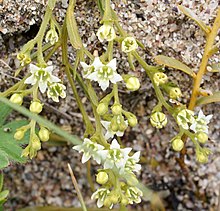Flax leaf
| Flax leaf | ||||||||||||
|---|---|---|---|---|---|---|---|---|---|---|---|---|

Medium flax leaf ( Thesium linophyllon ), illustration |
||||||||||||
| Systematics | ||||||||||||
|
||||||||||||
| Scientific name | ||||||||||||
| Thesium | ||||||||||||
| L. |
The linseed leaf ( Thesium ) is a genus of plants in the sandalwood family (Santalaceae). The genus received the common name flax leaf because the leaves of some species are similar to those of flax or flax ( Linum ).
description


Vegetative characteristics
The flax leaf species are perennial, less common annual herbaceous plants . Their stems are often woody at the bottom; less often they form short runners . They are semi-parasites (hemiparasites) that tap the roots of neighboring species through haustoria . The stems are prostrate or erect, simple or branched. The leaves are arranged alternately. The leaf blades are mostly linear-lanceolate, with entire margins, with one to five longitudinal nerves.
Generative characteristics
The inflorescence is a panicle with few-flowered branches or an ear. The bracts are foliage-like. Each flower has a bract and usually two bracts.
The hermaphrodite flowers are four or five-fold. The tepals are usually white to yellow-green on the inside and green on the outside. The corolla is tubular or bell-shaped and ends in four or five corolla lobes. The flower contains four or five stamens . The ovary is below and enveloped by the flower tube.
The fruits are nuts .




Systematics and distribution
The genus Thesium was established by Carl von Linné .
The genus Thesium comprises about 325 species, most of which are found in Africa. There are still numerous species in Europe and Asia, a few species also in South America and Australia. The main focus of the distribution is in the temperate zones.
The following species occur in Europe:
- Alpine flax leaf ( Thesium alpinum L. )
- Branched flax leaf ( Thesium arvense Horvátovsky , Syn .: Thesium ramosum Hayne ): In Europe, it is restricted to the east, south-east and eastern central Europe.
- Berg-Leinblatt or Bavarian Linseed Leaf ( Thesium bavarum cabinet )
- Thesium auriculatum Vandas : It occurs only on the Balkan Peninsula.
- Thesium bergeri Zucc. : It occurs in Europe in the Aegean Sea and on the Balkan Peninsula .
- Thesium brachyphyllum Boiss. : It occurs in Europe only in the Crimea .
- Thesium corsalpinum Hendrych : This endemic occurs only in Corsica .
- Bulky flax leaf ( Thesium divaricatum Jan ex Mert. & Koch ): It occurs only in southern Europe.
- Dolliner linseed leaf or low linseed leaf ( Thesium dollineri Murb. ): It occurs in Europe only in eastern Central Europe.
- Flax flax without a leaf or flax flax ( Thesium ebracteatum Hayne )
- Thesium hispanicum Hendrych : This endemic occurs only in northern Spain .
- Lying flax leaf ( Thesium humifusum DC. ): It occurs in Western Europe.
- Mountain flax ( Thesium humile Vahl ): It occurs in Europe only in the south.
- Thesium italicum A.DC. : This endemic occurs only in Sardinia.
- Thesium kernerianum Simonkai : It occurs only in Romania.
- Thesium kyrnosum Hendrych : This endemic occurs only in Corsica.
- Medium flax leaf ( Thesium linophyllon L. )
- Thesium macedonicum Hendrych : It occurs only in Macedonia .
- Thesium moesiacum Velen. (Is also placed as a subspecies subsp. moesiacum (Velen.) Stoj. & Stefanov to Thesium dollineri ): It occurs in Europe only in Bulgaria .
- Thesium parnassi A.DC. : It occurs only in Italy and on the Balkan Peninsula.
- Thesium procumbens C.A. Meyer : It occurs in Europe in the Ukraine and in Russia .
- Meadow flax leaf ( Thesium pyrenaicum Pourret , Syn .: Thesium pratense Ehrh. Ex Schrader )
- Thesium refractum C.A. Meyer : It occurs in Europe only in the southern Urals .
- Beaked flax leaf or beak-fruited flax leaf ( Thesium rostratum Mert. & Koch ): It occurs in Central Europe.
- Thesium sommieri Hendrych : This endemic occurs only in northern Italy .
- Thesium vlachorum Aldén : This endemic occurs only in northwestern Greece .
literature
- Radovan Hendrych: Thesium L. In: TG Tutin, NA Burges, AO Chater, JR Edmondson, VH Heywood, DM Moore, DH Valentine, SM Walters, DA Webb (eds.): Flora Europaea . 2nd, revised edition. Volume 1: Psilotaceae to Platanaceae . Cambridge University Press, Cambridge / New York / Melbourne 1993, ISBN 0-521-41007-X , pp. 83–86 (English, limited preview in Google Book Search).
- Karl Heinz Rechinger : Santalaceae. In: Gustav Hegi (first), Karl Heinz Rechinger (Hrsg.): Illustrated flora of Central Europe. Volume 3, part 1. 2nd Edition. Carl Hanser, Munich 1957, pp. 323-340.
- Jaakko Jalas, Juha Suominen (ed.): Atlas Florae Europaeae. Distribution of Vascular Plants in Europe. 3. Salicaceae to Balanophoraceae. Akateeminen Kirjakauppa, The Committee for Mapping the Flora of Europe & Societas Biologica Fennica Vanamo, Helsinki 1976, ISBN 951-9108-02-5 .